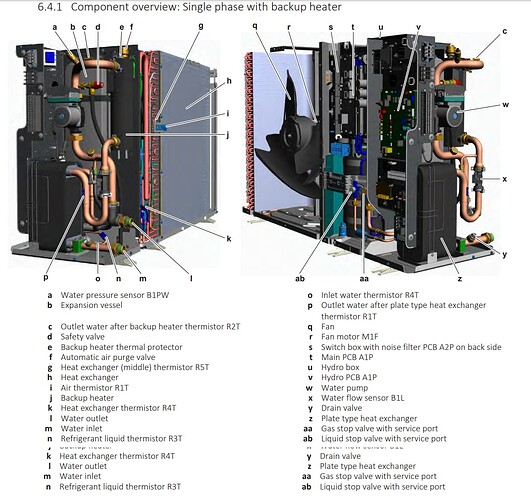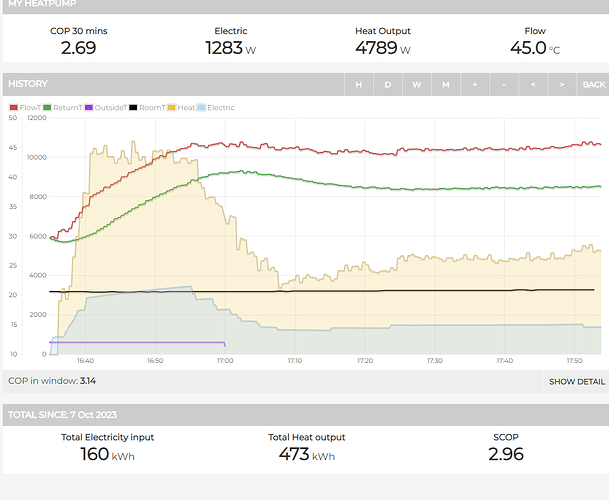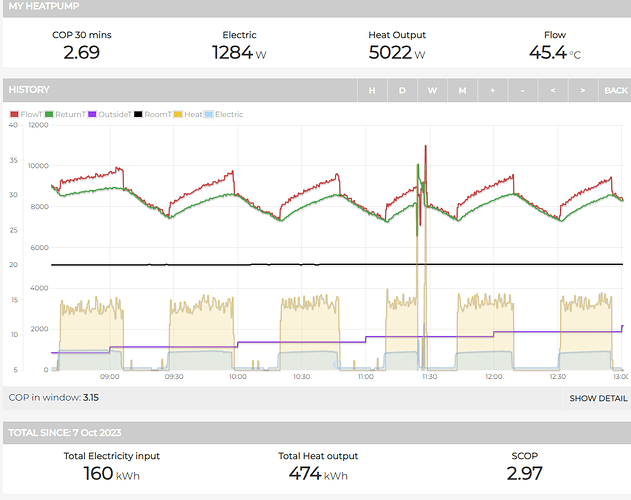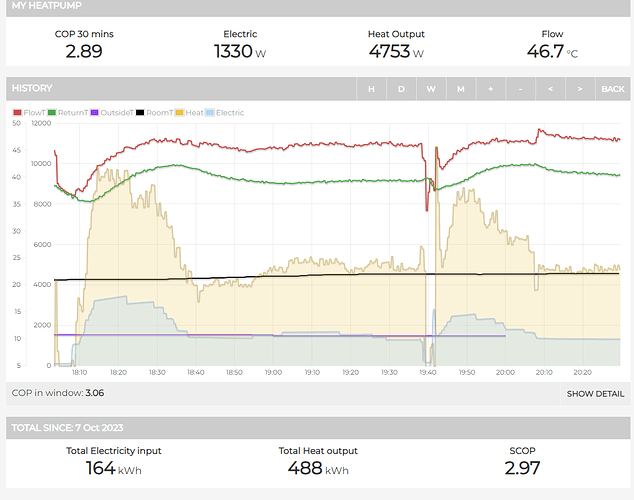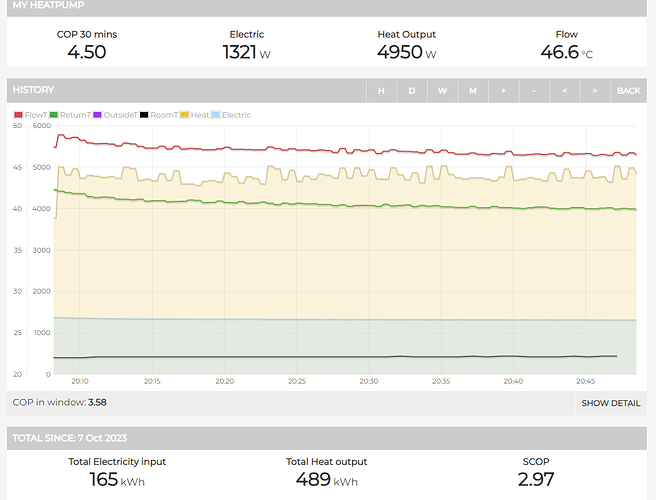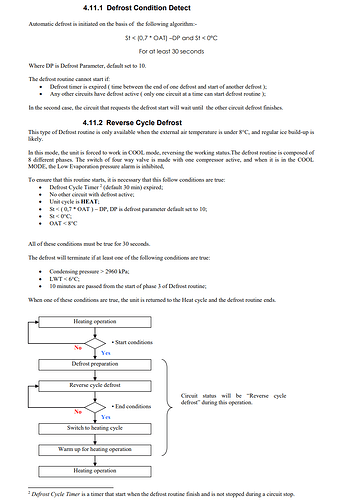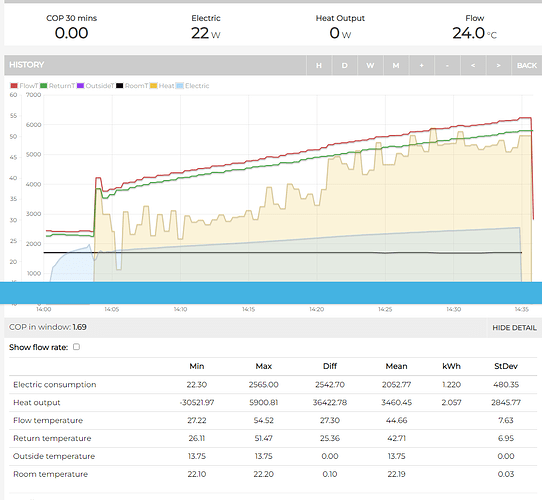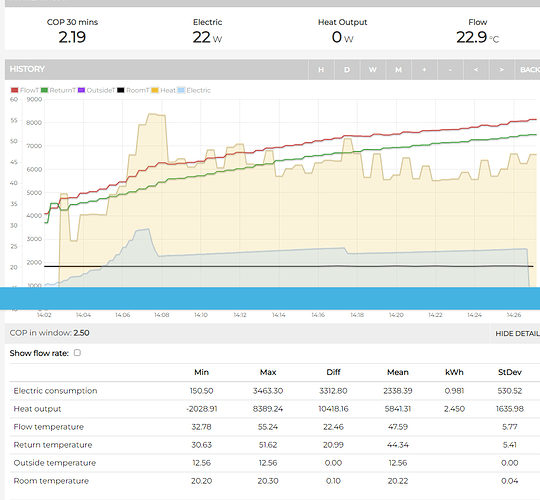same question
Sorry, I missunderstood the question.
Can you try running it with room influence, e.g increase the weather comp curve but use the daikin thermostat to limit your house temperature… I know that goes against everything you hear that pure WC is always best but certainly @ColinS is running his with significant room influence as far as I remember. Im not super familiar with the exact settings Colin may be able to help.
Not quite. Your house can take 5 kW if the heat pump wants to put in 5 kW. The radiator temperature will rise (as it can’t get rid of 5 kW at ow temperature) and the unit will stop the compressor after a while but there is nothing preventing it running 5 kW if it wants to.
Ok. That rules out that simple option!
Next theory:
Let’s assume the heat pump does actually do what it says on the tin. Most appear to do so in steady state conditions.
Let’s say that there is entrained air in the system. The Sontex meter, due to the way it operates, cannot detect this and will not trip any error codes. Perhaps the consequence of air in the system is to soften the Vortex shedding that this meter relies upon for measurement (reduce the frequency) and to make the flow rate appear lower (and indeed less stable) as a consequence?
(the “ignorant of air in a system” potentially being both a blessing and a curse)
If this is the case; then given the extensive use of Sontex meters by PassivSystems and others on DECC/BEIS/DESNZ funded heat pump efficiency trials and the likelihood that these were similarly affected by air the UK government might inadvertently have done heat pumps a disservice by underreporting the heat delivered. That would be quite the outcome for the books.
Removing air from low temperature systems with spaghetti pipework is often a bastard. If there is any dissolved in the water then the heat meter (as the lowest pressure point by necking down / Bernoulli and especially where mounted on the return before the system pump) will be the place that it forms bubbles.
What is your system fill pressure? Dare you fill to 2.5 bar (to try squash air bubbles so that they remain dissolved) and rerun the experiments?
Can you force a lower system flow rate by shutting down some radiators? That would reduce the system pressure drops and the Bernoulli effect at the meter.
Mount the meter on the flow instead so that the static pressure is higher? Just under where that temperature probe pocket is located looks perfect.
Naff hot water COP would also hint at this air issue perhaps having legs. Flowrates are higher in DHW mode and temperatures are higher. Both of these will tend to drop more dissolved air out as bubbles in the meter flow sensor.
None of this explains the reduction in COP at lower flow temperatures. That appears real / it looks like these units don’t like to run long and low. “Ha!” as they say. Every day a school day.
That is what I have been doing since Monday afternoon.
I tried pure WC from Sunday afternoon to Monday afternoon. It gets too hot in here at the lowest flow temperatures I can run so I went back to WC with the Madoka limiting house temperature.
This seems to be the best I can do at the moment.
I do see periods where performance in terms of COP is better but they are not prolonged and I guess they just represent times when conditions are more suited to my house and the weather.
I can’t see that I have installed the heat meter incorrectly and the electricity consumption agrees with my other sources of data. The heat produced seems broadly in line with the Daikin data but Wednesday this week looks a bit odd as I commented earlier.
Hi Marko,
My DHW seems quite good now. I have stopped reheating and now heating the tank to 50c once a day at 14.00.
The COP for this is 3.0, not far behind my heating with a flow of 32/33c.
Do you think my DHW is now doing ok or should do better.
The system is filled to 1.7 bar and runs at 2 bar or so, I might be a bit scared of filling to 2.5, you might have noticed some push fit connections? Fitted by the previous owner of the house, not me.
I have seen videos about plastic pipe and push fit connections and my gut feeling is they would be ok but I can’t honestly say I am 100% confident.
Maybe running the heating at the highest possible flow temperature for a while would help?
I think the heat meter has been configured to go on the return side and something would have to change to mount it on the flow.
Maybe @TrystanLea could give some guidance?
John guest push fit. Yikes yes. Do not touch pressure!
As a first pass you can just bung the meter on the flow. Strictly speaking it needs reconfiguring with the sontex software afterwards but the error there will only be a couple of % max due to how close the two temperatures are anyway.
If my heat meter was under reporting heat produced how could we explain the data from my Daikin MMI controller?
That is reporting the same or less heat produced.
Maybe I have air in the heat exchanger as VInny suggested.
I have just started running an experiment. I have turned the room target temperature up to 30c and gone +10c on the WD curve.
We’ll see what happens but my prediction is it will be no less efficient than my `normal’ heating setup.
My heating up to this point today has been around a COP of 3.2
So far so good ![]() It is behaving exactly as I expected, unfortunately.
It is behaving exactly as I expected, unfortunately.
How can this be as good/bad
as this?
My COP for the day is actually improving from what I am now doing.
It cannot be right?
Just got this email from Octopus, it’s hilarious!
Hi Matthew,
We’ve now been installing heat pumps for 12 months, and through installing heat pumps and having conversations with you, our customers, we believe there are more additional benefits a heat pump can provide.
Improving the efficiency of a heat pump is very much linked to how a heat pump is controlled at home. Having data that shows how your heat pump is running is just the kind of information that we need to improve our offering.
Our developers have been busy adding a function to the Octopus app, that talks to your Daikin app (ONECTA) and collects data from your heat pump at various times throughout the day.
In addition to the data helping us work out the best way to set up your heat pump, it can also tell us when your heat pump isn’t running as it should be. Regular monitoring can help us spot when your heat pump “skips a beat”, and we could even contact you to schedule a visit before you even know there’s anything wrong. In extreme cases, if your heat pump isn’t running efficiently, it could even save you lots of money.
All data is protected, but don’t worry, we will not collect personal data, just information on the performance of the heat pump.
)
)
)
)
)
I don’t see how Octopus will be able to work out the efficiency of my heat pump as the Daikin ONECTA app does not report heat produced, only electricity consumed.
What made the heat pump stop at 19.38 and restart at 19.41?
The requested room temperature had not been reached and neither had the flow temperature as it was obviously below the WD curve.
I don’t understand why it wouldn’t keep running
Not that it matters in this case but it happens all the time and I don’t understand why it just doesn’t keep running whilst heat is still requested.
It stops, cools down and then uses more electricity to heat up to where it was or even higher.
Really good, shouldn’t I be able to do better than this at lower flow temperatures? The house is now 24.8c
Looks like a defrost. The coils in the outside unit have frosted* up, and the heating is run in reverse to borrow heat from the house to melt the ice, before returning to regular operation. Note how flow temperature drops below return temp.
However, given the outside temperature is above 10C, I’m surprised to see the coils icing up. Is it especially humid out tonight? I could be wrong, and that’s not what is happening, but it’s what it looks like. Worth looking at the outside unit, see how cold and wet it is.
*Maybe the heat pump thinks it’s iced up, but hasn’t? Flow rate is quite low at 10 l/min and jumped up to 20 l/min before it started the defrost. Not seen this pattern happening at other times.
Yeah, I know, I’ve already connected to the Daikin API, and it doesn’t supply that information, which is why it’s not in the app. That doesn’t mean that it’s not being reported by the MMI to the Daikin cloud… I was thinking of asking them if there was any chance they could make it available, and while they’re at it, provide the raw figures for all the graph columns on the MMI! Maybe Octopus have more clout, because they’re going to need that info to do what they suggest. The MMI has loads more info which might also be in the cloud, but not made available, like flow rate, heat exchanger plate temp and so on, as you know. Grr. Trying to read the stupid graphs and interpolate, then add the numbers up is a total PitA.
Hi Tim,
I don’t know why it defrosted. There was no ice on it. I have a very good view of the back and side of it because of where it had to be located.
Unfortunately they are(some are) defrosting based of a set equation defined by each manufacturer.
Random example:
Some are comparing the air temp sensor vs evaporator temp sensor within an amount of time.
Let’s say, if the the evaporator is colder than expected at a given outdoor temp for longer than x amount of time, it is assumed it has ice on it.
Could be onto something.
If the unit were low on refrigerant it would ice up early. And be “off” in terms of performance.
It ought not to be; given that it’s a sealed unit; but it isn’t implausible that it was factory faulty or got bumped in the journey to being installed.
Unusual for a monobloc though.
It’s great that they’re interested.
Bite their hand off then ask them why the unit, according to it’s own measurements and your heat meter, isn’t doing what it says on the tin?
Thanks Marko.
I am beginning to think there is something not right with my heat pump. I have heard nothing from Octopus about coming to set it up but I may contact Daikin on Monday and see what they have to say.
I have linked the heat pump with Octopus, I think it would be foolish not to. The funniest bit was them thinking they will notice a problem before me!
Just to demonstrate my ignorance once more :0 during my test yesterday evening why was the heat production high to start with and then drops to a lower level? The flow temperature had not been reached and the heat demand was high as I was 7c from my requested room temperature.
I am surprised it didn’t carry on producing 10kW of heat like it did at the beginning.
What was the target flow temperature? It looks like it boosted up to 47 C and then reduced output to maintain that level, which is expected behaviour for a heat pump.
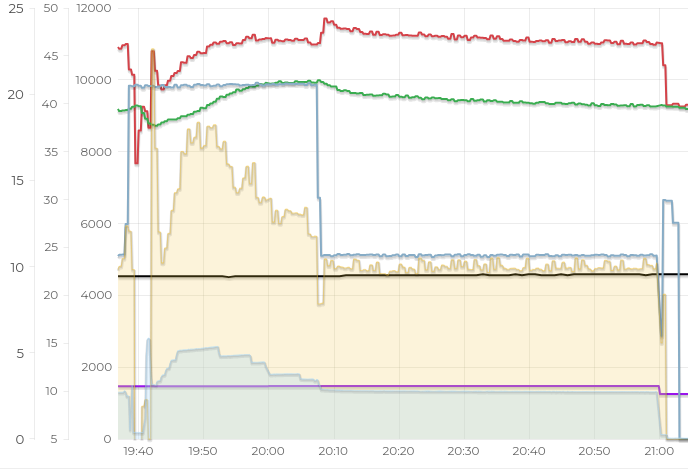
Yes, requested flow would have been at 47c.
So I know I’ll sound a bit thick, but I am learning and trying to understand what may be wrong with my set up.
The flow temperature was reached and maintained but the electricity input dropped and the flow rate.
Does that mean that the initial amount of heat input is not sustainable and it had to drop to around 5kW?
What made it reduce heat output. With more electricity and flow rate it could have carried on producing 9kW of heat from what I can see?
